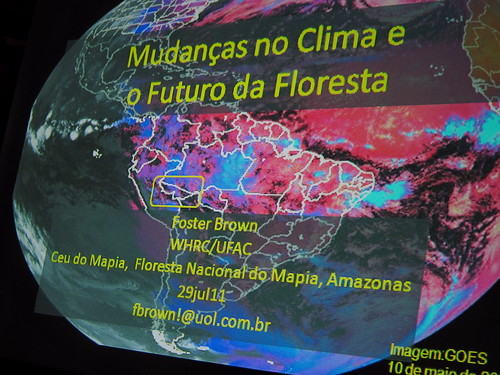
(Leia em português aqui)
At the end of July I had the pleasure of accompanying Foster Brown to the village of Ceu do Mapia, a 28 year-old Santo Daime spiritual community of nearly 1,000 people living in the Floresta Nacional do Purus in Amazonas State. Foster is a professor of Ecology at the Federal University of Acre and a scientist with the Woods Hole Research Center. His current specialty is satellite monitoring and remote sensing of the climate and the forest.
Recently, Foster has been traveling to the cities and forest communities in the tri-national region called by the acronym MAP -- Madre de Dios in Peru, Acre in Brazil and Pando in Bolivia -- which is one of the great centers of Amazonian biodiversity and also a center of a new economy that combines globalized commerce and local economic development.
Foster says, "I especially enjoy visiting the communities in the forest. My talk is not abstract for them. They see what is happening and they are real curious about what's causing it."
During the car ride from Rio Branco to the Purus River, Foster asked, "Lou what do you see as the blog story about this trip; after all, I'm just going to make a presentation?" I had to say, "I don't really know but a trip to Ceu do Mapia usually provides lots of stories. Let's see what rises to the surface as really important."
As we drove the 120 miles from Rio Branco, the road cut through a broad strip of deforested land converted to cattle pasture (there are about 450,000 cows spread across the district). We asked our driver, who lives in Boca da Acre, why there was so little traffic on the newly-paved road and how things are going for the townspeople.
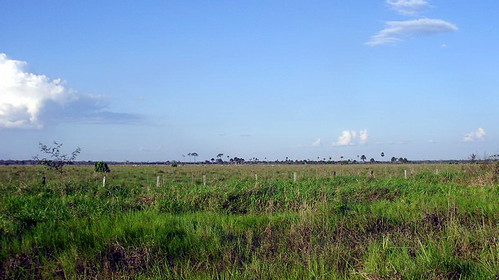
Pasture land along road to Boca da Acre
He said that there was a lot of unemployment because the government has been stopping deforestation but people were hopeful about the future because a new port and depot are planned for shipping products from the Purus Valley along this road to the new inter-continental road to the Pacific.
After spending the night in Boca da Acre we headed down to the dock at the confluence of the Acre and Purus rivers and and were on our way.
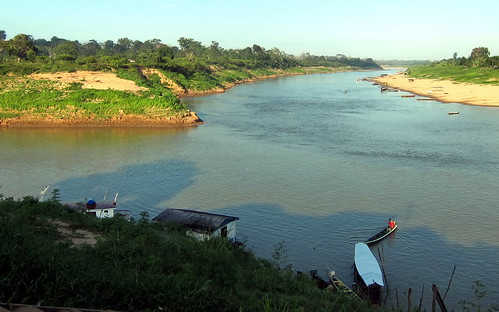
Confluence of Acre and Purus rivers

Jose
Our boatman Jose said that the river was already pretty low -- two months earlier than during last year's record drought -- and that we would not be able to travel by water up the little river to Mapia.
There were lots of signs along the Purus of how far the water level had fallen. Check out the beached boat to the right in the photo below -- it's sitting 30-40 feet up the slope .

The igarape (small river) to Mapia was low and difficult to enter.
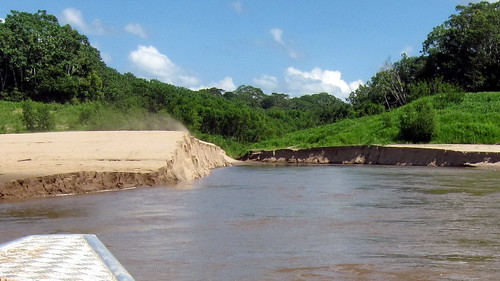
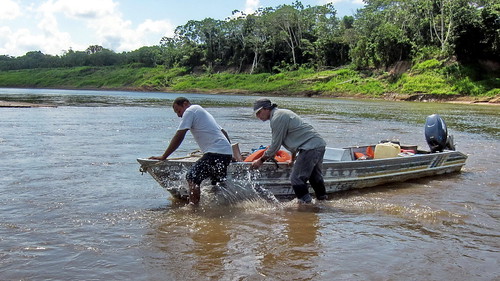
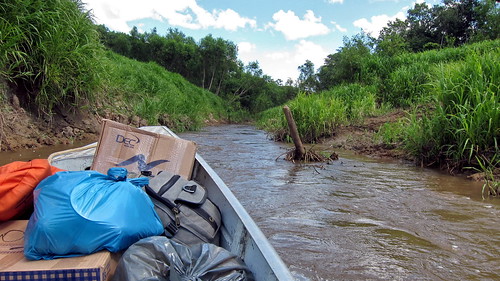
Due to the shallow water, we had to stop at a farm that supplies some of the food for the community. We continued some 44 kilometers (about 30 miles) along a small road that runs through the forest parallel to the igarape.
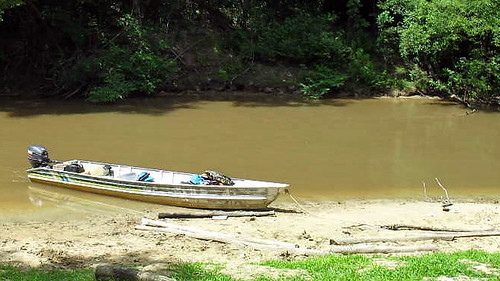
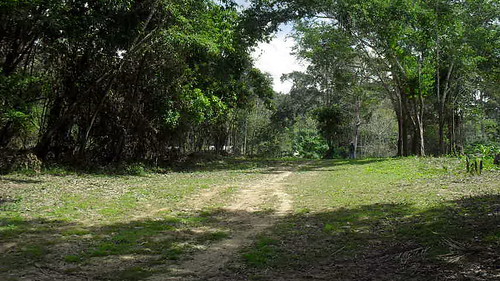
At Mapia there were lots of boats but little movement along the igarape. Ever since the severe drought of 2005, the community has been inaccessible by boat during the dry season (which is why the road had to be built). In 2005, it was thought that the severe drought was a one in one hundred-year event. But the 2010 drought was more severe and now there's an even chance that this dry season will bring more of the same, or worse.
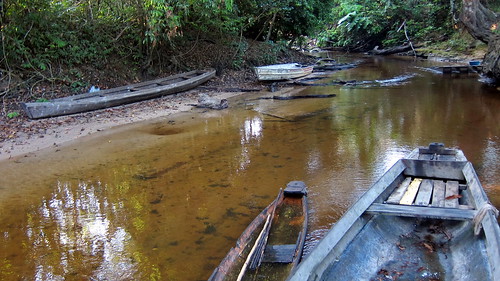
Some long-range climate models now suggest that this kind of situation may become a new "normal" and that the Amazon Basin is losing it's pattern of regular seasons. The changing climate was the subject of Foster's evening talk.
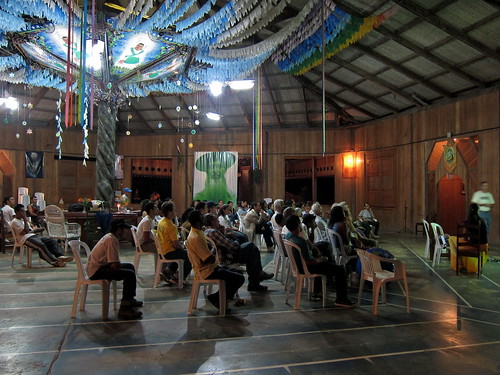
The presentation took place at the spiritual center of Mapia, the beautiful church that is also Matrix of the globally-spread Cefluris line of the Santo Daime movement. The community was founded by Padrinho Sebastiao Mota de Melo. His son, Padrinho Alfredo -- the present leader of the line -- and many others were in attendance.
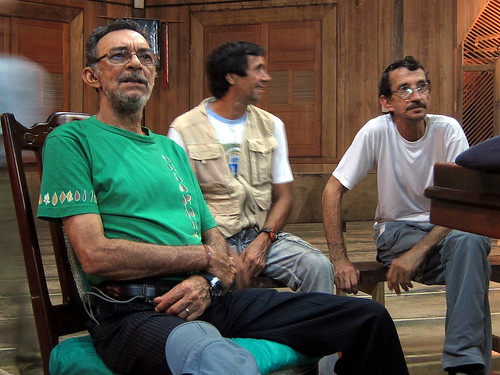
Foster began by describing the global weather system and how the warming of global climate was influencing the wet and dry seasons of Amazonia. He presented the historical record showing that current climate events were due to more than "natural variation" and how the new patterns were impacting the local forest.

The short story is that the greenhouse gases accumulated from the massive fossil fuel emissions of modern industrial society and the clearing forests to grow food for expanding world population have raised average global temperatures to a destabilizing level. One result is the warming of sea surface temperatures in the oceans which in turn determine the patterns of where and when rainfall is distributed over land. The result is more erratic weather, including many extreme events such as floods and droughts.
In Amazonia, under the old normal pattern, occasional dry season rain and the full return of the rainy season could be counted on to keep the forest moist and limit the fires that had been set to clear agricultural land and often escape into the forest during the "burning season." The natural "fire-fighting" service of predictable seasonal rainfall is lost and the weather pattern becomes more erratic, giving both more floods and severe droughts. A reinforcing feedback of more droughts, more fires, more emissions and higher temperatures occurs and the situation gets increasingly worse.
Although news of flooding in Brazil has come mostly from the South, it occurs sometimes in the Amazon as well, but severe drought has been the most noticeable local event. Indeed, Acre State has been the epicenter of recent droughts. Bottom line -- this region seems to be moving toward a new climate that includes more uncertainty and extreme weather events.
Of course, people were concerned and asked, "What can be done about the 'big picture' and what can we do here?'
The next day's workshops were devoted to those questions. The morning session was built around understanding the interconnections be the Amazon forest and the climate. Foster began by locating Mapia in the global picture.

Then a hand's-on experiment was set up outside by tying a plastic bag around a clump of leaves on a tree, an experiment that the group would return to after the morning session which was built around discussing the implications of the new science of climate modelling. It began with video by the Brazilian climate scientist Antonio Nobre.
Climate scientists have a challenging topic. Like fish in the ocean not seeing the water, we humans don't perceive the atmosphere around us. In Brazil they say, "The heart can feel only what the eyes can see." With poetry and visuals, Nobre paints a more vivid view with animations of global moisture circulation that make that vital connection. Indeed, this new picture, like the view of earth from space, may be the "game changer" for our awareness.
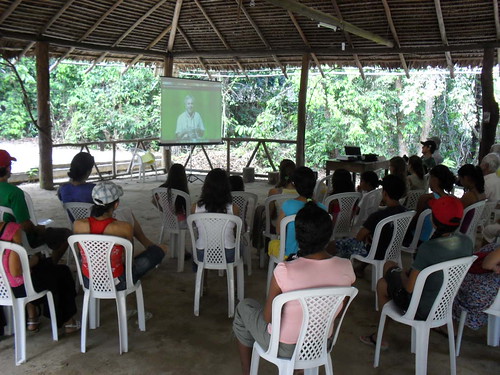
There's really no way to communicate effectively the complexities of the Amazon water cycle with dry words, facts and figures. It's a "must-see." I ask you to watch the video to "see and feel for yourself."
[note: to see the translation subtitles, start the video and watch for the red CC button at the lower right of the player frame. Clicking on it gives a choice of English, Portuguese or Spanish subtitles.]
Foster spent the rest of the morning explaining the intricacies of the Amazon climate. The Amazon Basin receives and returns to the ocean about 20 percent of all the rain that falls on land. Every day it empties 17 billion metric tons of water into the sea. But where does all this rainfall come from? Basically, there's a river in the sky, a global moisture circulation system that exchanges water between earth and ocean.
While it's easy to understand that gravity causes atmospheric moisture to fall to earth as rain, it's more challenging to know how the moisture travels upward into the atmosphere. Some of it, of course, is the result of simple evaporation but far from all. Trees, because their roots draw ground water and their leaves expel moisture in a process called transpiration, function as pumps sending water skyward. And the hotter it is, the more they pump -- functioning like geysers.
Then Foster took everyone outside to observe the experiment that had been set up earlier with a plastic bag tied around a small clump of leaves. The heat of the tropical sun had been forcing transpiration and moisture had been invisibly traveling upward. But, trapped by the plastic bag, it was now highly visible.
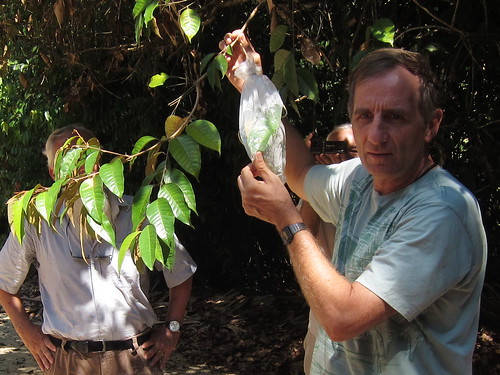

A single large tree can pump as much as 1,000 liters of moisture each day. The Amazon Forest contains 600 billion trees and the river in the sky receives 20 billion metric tons of water daily, 3 billion more than the Amazon River empties into the ocean. The process is driven by the heat of the sun. Each day there is a great pulse of water into the sky. As the trees act as geysers, the Amazon Forest becomes the heart pumping the circulation of a global climate system.
On that note, we took a break for lunch.

The afternoon session was devoted to discussing what might be done.
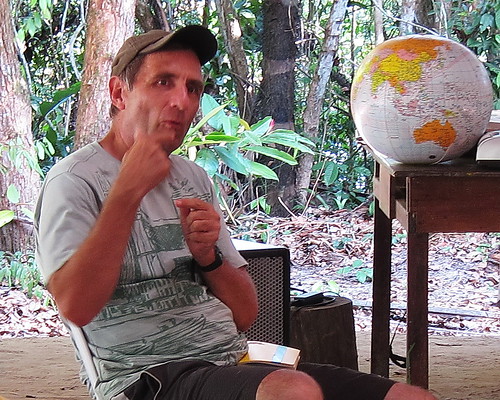
Foster put a lot of emphasis on the global connection and the need to reduce emissions from the use of fossil fuels and noted that another 20 percent came from deforestation. He talked of the widely agreed-to scientific conclusion that the world needed to reduce atmospheric concentrations of carbon dioxide to 350 parts per million. He stressed the global citizen action campaigns that are being organized under the banner of 350.org and suggested that Mapia might participate in the up-coming Moving Planet campaign scheduled for 24 September 2011.

Padrinho Alex Polari talked about the the local initiatives that were underway at Mapia which include agro-forestry programs where food and trees are grown together in a style that copies a natural forest and the programs of environmental health and recycling. Both recycling and growing food locally reduce fossil fuel consumption. And agro-forestry can help restore the soil and reduce further deforestation.
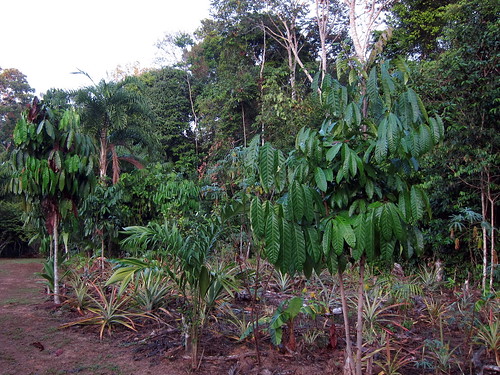
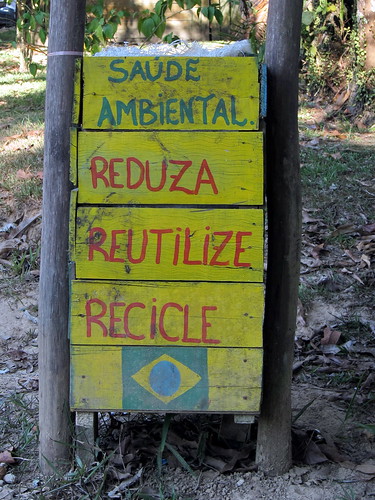
We then sat in a big circle to discuss how Mapia might fit into the global picture. It was recalled that Antonio Nobre had mentioned a powerful idea in the video. He said that, although human activity had caused a great deal of damage, the situation could be reversed by restoring forests -- that planting trees and restoring forests could be like "gardening back the biosphere."

It was suggested that the community of Mapia could become such a gardener by finding ways to halt deforestation and grow food along with trees; that stories of what it was doing could be like seeds spread into the world. It could be a model.
Then people sang a famous hymn of Mestre Irineu who was the founder of the Santo Daime religion.
Gardener
My Mother, my Queen
It was She who entrusted me
For me to be a gardener
In the garden of beautiful flowers
In the garden of beautiful flowers
There is everything that I search for
There is splendor and beauty
There is everything that God gives me
Everyone receives
The flowers that come from there
But nobody pays attention
Nobody knows how to make good use of them
To take care of this garden
One needs to pay much attention
Because the flowers are very delicate
They cannot fall to the ground
The garden of beautiful flowers
Always needs watering
With prayers and tenderness
To Our Universal Father
When the circle broke, Foster gathered with a group at the community telecommunications center to demonstrate how to link up with the satellite monitoring websites and the Moving Planet campaign. The process of Mapia connecting with the world and becoming a model was definitely in the air.
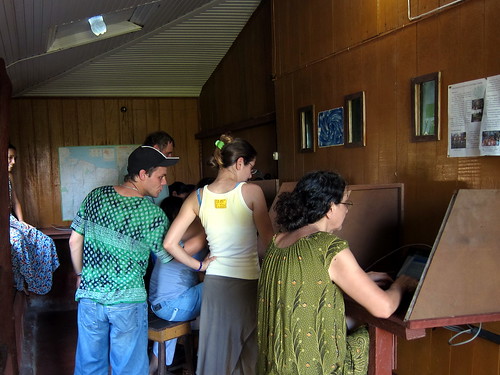
Following a long day of workshops, Foster and Alex spent many hours discussing their projects, plans and hopes for a better world.

The next day we departed from Mapia with many lovely memories of the way we had been so graciously hosted in the home of Padrinho Alex and Sonia Polari
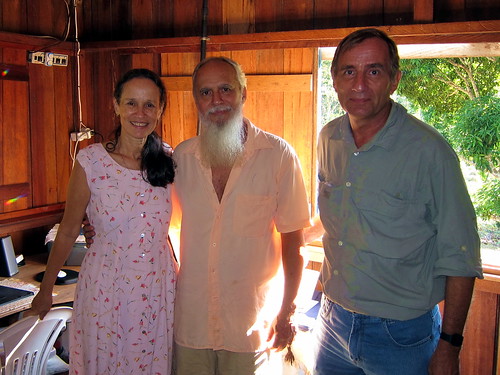
and the way Padrinho Alfredo made us feel so welcome in the community.

Last, but surely not least, would be the memory of the young people who are connecting with the world and becoming the gardeners of the future.







8 comments:
thanks for sharing such a great experience in the amazon!
But why not just pray to Ogum an the queen of the forest? Oh thats right..because they are make believe like the tooth fairy and jesus. I love how religious people like to cherry pick science, but when scientist say based on evidence that religion is man made bs, the conveniently dismiss it.
It's also interesting how the biased blogger will never allow any comments that dont agree with the spiritually brain washed preferred comments.
Thank you Anonymous for your most provocative words I believe that a dialogue could be of interest to readers, and even more so if you signed with a real name.
Yes, I am a biased blogger, VERY biased. For the past 30 years, I have been a devotee and follower of the forest. The forest is my church. She requires no symbolism or institutionalization beyond the fact that She is. My relationship is one of a faith much deeper than a belief or an organizational "belonging.".
However, if a tooth fairy would appear tomorrow and offer a voice and support for the forest, I would surely support her efforts. Similarly, even though my own background is nonreligious secular Jewish, I fully endorse and support the fact that the National Council of Catholic Bishops in Brazil has organized a campaign in their 14,000 parishes to defend the forest against the bad changes to the Forest Code that are being proposed in Brasilia.
One of the many beauties of the Nobre video (did you watch it?) is the way he builds a bridge between science and spirit. He points out that indigenous spirituality taught of the relationship between trees and the Amazon water cycle long before science "discovered" it. No matter whether the teacher is perceived as a giant anaconda, the tooth fairy or a computer model, I fully endorse this kind of bridge-building and would like to see more of it.
Of course, this new type of connectivity between science and spirit is resisted by fundamentalists and deniers of all kinds and they certainly are making a lot of mischief in our contemporary world as they fight for various forms of separation.
One by one, people are making a choice about where they will stand. I hope it will be with the forest.
Thanks for the wonderful article, pics and video Lou! Shared widely...
Thanks Lou, I missed the workshop while in Mapia as I was in another workshop for the Florais and your account of it makes up for that. I know the workshop was received with much interest locally as it is clear the water levels are dropping in the Iguarape. Your account of the workshop is useful to catch up and understand what is visible locally and connecting it to the bigger picture of climate change. I will be sending the link to my friends who care about the forest..
Thanks you, Lou. Very useful and inspiring.
Thanks Lou - Great reporting/sharing/teaching.
I sure learned a lot!
So appreciate all you do.
Love ya man!
Don
Dear Lou,
I was amazed by everything I read and saw in this story; you do so well to relate your visit to Mapiá with your friend Foster.
I felt like I traveled with you on the road that cuts through a landscape of deforestation, to travel by the low river and small lane through the forest that leads us to Mapiá.
The photographic images of people getting visitors show their interest about the things would be brought to them.
I was extremely impressed with the video presented in which the scientist Antonio Donato makes a beautiful presentation of the wonderful system we inhabit. Today I live in the Amazon region and had not realized that I am in the heart of the planet. This is really fascinating. I had not realized how special is the Amazon to the health of our small and beautiful planet.
I learned a little about the nature’s technology through its cyclical system where each creature, animated or not, works together to operate the living machine to work in perfect harmony.
More than a scientific approach, merely informative, this report also shows us the spirit of the forest. That great spirit that spoke to Davi Kopenawa about the importance of not deforesting allows us, in the same way, to approach the community of Mapiá and reflect a need for attention to impregnate in all of us the need of preserving the environment.
And how well speaks Mestre Irineu’s hymn:
"My Mother, My Queen
It was she who taught me
For me being a gardener (...)
To ensure this garden
Need attention
The flowers are very delicate
They can not fall to the ground (...)"
This song is a call to look more closely at beautiful garden that surrounds us, and more than that, it proposes to us to learn the craft of gardening, making ourselves good gardeners, tending our Lord’s garden with love.
Thanks Lou for this beautiful story that brings us to you.
Cristiane A Costa
Post a Comment